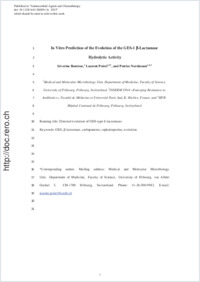In vitro prediction of the evolution of the GES-1 β-lactamase hydrolytic activity
- Bontron, Séverine Medical and Molecular Microbiology Unit, Department of Medicine, Faculty of Science, University of Fribourg, Switzerland
- Poirel, Laurent Medical and Molecular Microbiology Unit, Department of Medicine, Faculty of Science, University of Fribourg, Switzerland - INSERM U914 'Emerging Resistance to Antibiotics', Faculté de Médecine et Université Paris Sud, France
- Nordmann, Patrice Medical and Molecular Microbiology Unit, Department of Medicine, Faculty of Science, University of Fribourg, Switzerland - INSERM U914 'Emerging Resistance to Antibiotics', Faculté de Médecine et Université Paris Sud, France - HFR-Hôpital Cantonal, Fribourg, Switzerland
-
05.01.2015
Published in:
- Antimicrobial Agents and Chemotherapy. - 2015, p. AAC.04450–14
English
Resistance to ß-lactams is constantly increasing, due to the emergence of totally new enzymes, but also to the evolution of pre-existing ß-lactamases. GES-1 is a clinically-relevant extended-spectrum β-lactamase (ESBL) hydrolyzing penicillins and broad-spectrum cephalosporins, but sparing monobactams and carbapenems. However, several GES-1 variants (i.e. GES-2 and GES-5) previously identified among clinical isolates display an extended spectrum of activity toward carbapenems. To study the evolution potential of the GES-1 β-lactamase, this enzyme was submitted to in-vitro directed evolution, with selection on increasing concentrations of the cephalosporin cefotaxime, the monobactam aztreonam, or the carbapenem imipenem. The highest resistance levels were conferred by the combination of up to four substitutions. The A6T, E104K, G243A variant selected on cefotaxime, and the A6T, E104K, T237A, G243A variant selected on aztreonam, conferred high resistance to cefotaxime, ceftazidime, and aztreonam. Conversely, the A6T, G170S variant selected on imipenem conferred high resistance to imipenem and cefoxitin. Noteworthy, the A6T substitution involved in higher MICs for all ß-lactams is located in the leader peptide of the GES enzyme, therefore not present in the mature protein. Acquired cross resistance was not observed since selection with CTX or ATM did not select for resistance to IPM and vice versa. Here we demonstrated that β-lactamase GES-1 exhibits peculiar properties with a significant potential to gain activity toward broad-spectrum cephalosporins, monobactams, and carbapenems.
- Faculty
- Faculté des sciences et de médecine
- Department
- Médecine 3ème année
- Language
-
- English
- Classification
- Pathology, clinical medicine
- License
-
License undefined
- Identifiers
-
- RERO DOC 234262
- DOI 10.1128/AAC.04450-14
- Persistent URL
- https://folia.unifr.ch/unifr/documents/304207
Statistics
Document views: 93
File downloads:
- pdf: 168
